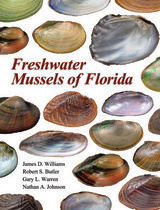2 books by Warren, Gary

Freshwater Mussels of Florida
James D. Williams, Robert S. Butler, Gary L. Warren, and Nathan A. Johnson
University of Alabama Press, 2014
An exhaustive guide to all aspects of the freshwater mussel fauna in Florida, Freshwater Mussels of Florida covers the ecology, biology, distribution, and conservation of the many species of bivalve mollusks in the Sunshine State. In the past three decades, researchers, the public, businesses that depend on wildlife, and policy makers have given more attention to the threatened natural diversity of the Southeast, including freshwater mussels. This compendium meets the increasingly urgent need to catalog this imperiled group of aquatic organisms in the United States.
Each entry in this definitive guide provides a detailed description and multiple depictions of the species as well as select characteristics of its soft anatomy and miscellaneous notes of interest. Individual distribution maps pinpoint the historical and present occurrence of each bivalve species and are just one component of the rich set of 307 mussel and habitat photographs, seventy-four maps, and thirteen tables that illustrate the book. Of particular interest are remarkable electron micrographs of glochidia, the specialized larval life history stage parasitic upon fishes.
Freshwater Mussels of Florida will be of lasting value to state and federal conservation agencies as well as other government and nongovernment entities that manage aquatic resources in Florida. The research provides a key baseline for future study of Florida mussels. The survey results in this guide, along with extensive reviews of historical mussel collections in natural history museums, provide a complete picture of the Florida mussel fauna, past and present.
Each entry in this definitive guide provides a detailed description and multiple depictions of the species as well as select characteristics of its soft anatomy and miscellaneous notes of interest. Individual distribution maps pinpoint the historical and present occurrence of each bivalve species and are just one component of the rich set of 307 mussel and habitat photographs, seventy-four maps, and thirteen tables that illustrate the book. Of particular interest are remarkable electron micrographs of glochidia, the specialized larval life history stage parasitic upon fishes.
Freshwater Mussels of Florida will be of lasting value to state and federal conservation agencies as well as other government and nongovernment entities that manage aquatic resources in Florida. The research provides a key baseline for future study of Florida mussels. The survey results in this guide, along with extensive reviews of historical mussel collections in natural history museums, provide a complete picture of the Florida mussel fauna, past and present.
[more]

Strangers in Paradise
Impact And Management Of Nonindigenous Species In Florida
Edited by Daniel Simberloff, Don C. Schmitz, and Tom C. Brown; Foreword by Edward O. Wilson
Island Press, 1997
Invasive nonindigenous species -- plants and animals that have been introduced to an ecosystem from someplace else -- are wreaking havoc around the globe. Because they did not co-evolve with species already in the ecosystem, they can profoundly disturb species interactions and ecosystem function.The state of Florida has one of the most severe exotic species problems in the country; as much as a quarter of many taxa in Florida are nonnative, and millions of acres of land and water are dominated by nonindigenous species. Strangers in Paradise provides an in-depth examination of the Florida experience and of the ongoing efforts to eradicate or manage introduced species. Chapters consider: natural disturbance and the spread of nonindigenous species case studies of insects, freshwater invertebrates, fishes, amphibians and reptiles, birds, marine invertebrates and algae, and mammals methods of managing nonindigenous species including ecological restoration, eradication, "maintenance control," and biological control management on public lands the regulatory framework including the role of the federal government as well as state authorities and responsibilities Strangers in Paradise is the first comprehensive volume to address a large, diverse region and the full range of nonindigenous species, the problems they cause, and the methods and impediments to dealing with them. Throughout, contributors emphasize solutions and relate the situation in Florida to problems faced by other states, making the book an important guide for anyone involved with control and management of invasive species.
[more]
READERS
Browse our collection.
PUBLISHERS
See BiblioVault's publisher services.
STUDENT SERVICES
Files for college accessibility offices.
UChicago Accessibility Resources
home | accessibility | search | about | contact us
BiblioVault ® 2001 - 2024
The University of Chicago Press









